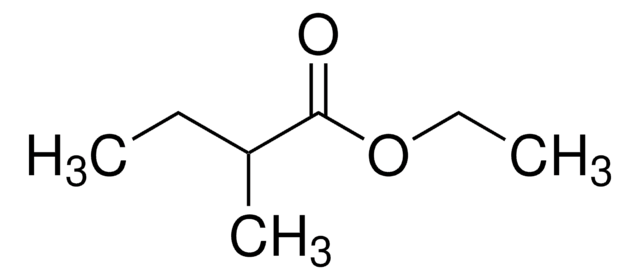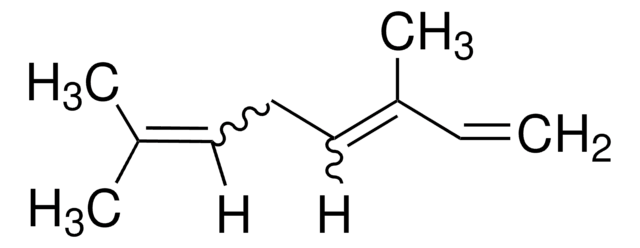W244317
Ethyl 2-methylbutyrate
natural, mixture of enantiomers, ≥98%, FCC, FG
Sinonimo/i:
Berry butyrate, Ethyl 2-methylbutanoate
About This Item
Prodotti consigliati
Grado
FG
Fragrance grade
Halal
Kosher
natural
agenzia
follows IFRA guidelines
meets purity specifications of JECFA
Conformità normativa
EU Regulation 1223/2009
EU Regulation 1334/2008 & 178/2002
FCC
FDA 21 CFR 117
Saggio
≥98%
Caratteristiche più verdi
Less Hazardous Chemical Syntheses
Use of Renewable Feedstocks
Learn more about the Principles of Green Chemistry.
sustainability
Greener Alternative Product
Indice di rifrazione
n20/D 1.397 (lit.)
P. ebollizione
133 °C (lit.)
Densità
0.865 g/mL at 25 °C (lit.)
applicazioni
flavors and fragrances
Documentazione
see Safety & Documentation for available documents
Allergene alimentare
no known allergens
Allergene in fragranze
no known allergens
Categoria alternativa più verde
Organolettico
apple; green; fruity
Stringa SMILE
CCOC(=O)C(C)CC
InChI
1S/C7H14O2/c1-4-6(3)7(8)9-5-2/h6H,4-5H2,1-3H3
HCRBXQFHJMCTLF-UHFFFAOYSA-N
Cerchi prodotti simili? Visita Guida al confronto tra prodotti
Categorie correlate
Descrizione generale
Avvertenze
Warning
Indicazioni di pericolo
Consigli di prudenza
Classi di pericolo
Flam. Liq. 3
Codice della classe di stoccaggio
3 - Flammable liquids
Classe di pericolosità dell'acqua (WGK)
WGK 1
Punto d’infiammabilità (°F)
78.8 °F - closed cup
Punto d’infiammabilità (°C)
26 °C - closed cup
Dispositivi di protezione individuale
Eyeshields, Faceshields, Gloves, type ABEK (EN14387) respirator filter
Scegli una delle versioni più recenti:
Possiedi già questo prodotto?
I documenti relativi ai prodotti acquistati recentemente sono disponibili nell’Archivio dei documenti.
I clienti hanno visto anche
Global Trade Item Number
| SKU | GTIN |
|---|---|
| W244317-100G-K | 4061837876738 |
| W244317-1KG-K | 4061837876745 |
| W244317-SAMPLE | |
| W244317-100G | |
| W244317-1KG | |
| W244317-20KG-K | 4061837876752 |
| W244317-4KG | |
| W244317-4KG-K | 4061837876769 |
| W244317-SAMPLE-K | 4061837876776 |
Il team dei nostri ricercatori vanta grande esperienza in tutte le aree della ricerca quali Life Science, scienza dei materiali, sintesi chimica, cromatografia, discipline analitiche, ecc..
Contatta l'Assistenza Tecnica.








